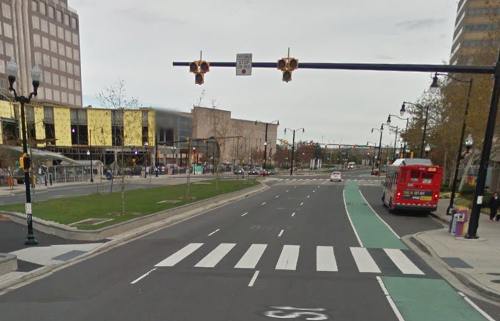Maryland shouldn’t outlaw this type of pedestrian crossing signal, says a Montgomery County Councilmember

Proponents of a new type of walk signal that’s gaining popularity in DC and Virginia say that the technology makes walking safer. In Maryland, though, the State Highway Authority (SHA) prohibits their use. That shouldn’t be the case, according to Montgomery County Councilmember and Transportation Committee Chairman Roger Berliner.
HAWK (High-Intensity Activated crossWalK beacon) signals tell drivers to stop at pedestrian crossings that are in the middle of a block or where there isn’t a traditional traffic light. People who want to cross press a button, which activates a yellow light that tells drivers to slow down and then a double red light telling them to stop.
One reason engineers like HAWK signals is that they have a low “warrant threshold,” meaning there are generally fewer barriers to putting them up than a normal traffic light. Another is that they allow drivers to proceed after the people who pushed the button have crossed.
But while HAWK signals can be an effective means of improving safety at crosswalks, they aren’t without criticism. They don’t look or light up like normal traffic lights, which can confuse drivers. And because they remain completely dark until activated by a pedestrian, some drivers may think the HAWK signal is not working and treat the intersection as a stop sign.
The fact that HAWK signals stay dark until activated is the primary reason Maryland’s SHA does not permit their use on state or local roads. Under the Maryland Motor Vehicle Code, a dark signal should be treated as a stop sign. It appears SHA has determined that HAWK signals are applicable to this section of the code.
In a letter to the Montgomery County Delegation to the 2017 General Assembly, Roger Berliner questioned the logic of Maryland’s restrictive amendments on “pedestrian hybrid beacons,” especially in light of what he sees as clear federal guidelines on how to install and use them. He asked the delegation to consider introducing legislation that would allow HAWK signals in Maryland:
“The reasons for this change from the federal guidelines are not clear to me. What is clear to me, however, is that HAWK signals can improve pedestrian safety on SHA-administered roads. I am asking that you give serious consideration to introducing legislation during the 2017 General Assembly that would require the state to adopt either 1) the Federal Highway Administration Manual or 2) the specific language of Chapter 4F in the Federal Highway Administration Manual.”
Noting that multiple Federal Highway Administration studies have shown that HAWK signals improve safety and compliance at pedestrian crossings, Berliner continued:
“I was the lead sponsor of legislation requiring Montgomery County to establish a framework and deadline for a Vision Zero campaign to achieve zero traffic deaths. The work of the County’s Vision Zero Working Group is ongoing, with a recommended action plan expected early next year. We have already seen too many tragedies occur in crosswalks, making improved crosswalk safety critical in the Vision Zero effort. HAWK signals are a proven solution in this regard that I believe we must embrace.”
Read the whole letter here.


